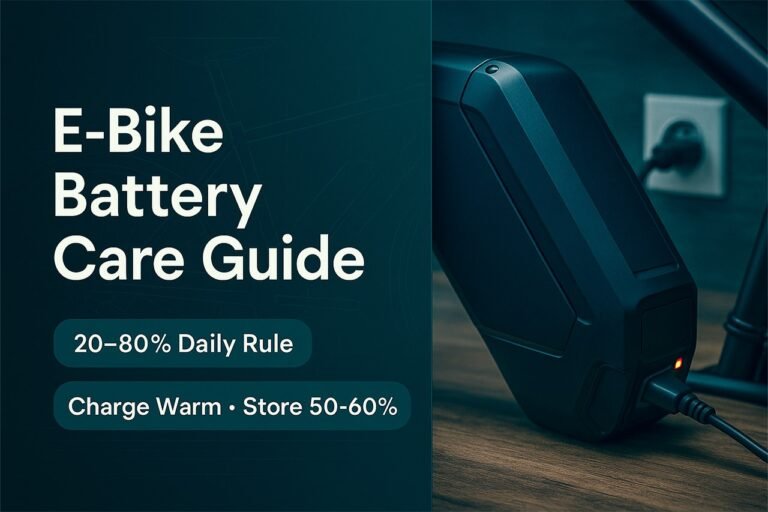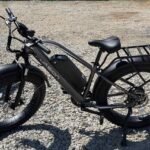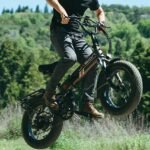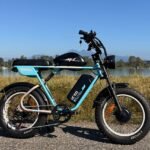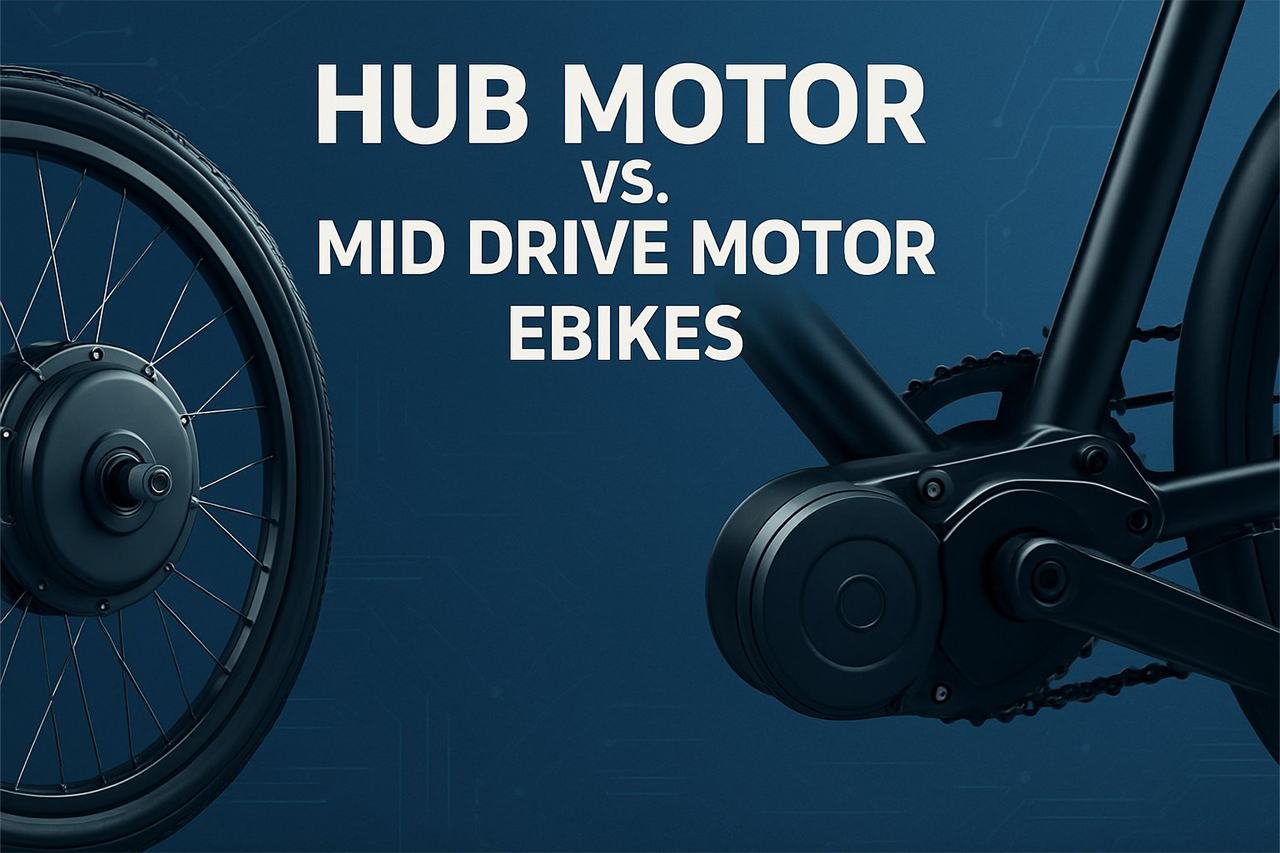
Electric bikes have revolutionized personal transport, and one of the most hotly debated questions among new buyers is: Should you choose a hub motor or a mid drive motor ebike? While both power your ride in their own unique ways, their differences run deeper than you might expect. This article explores these two core technologies so you can confidently pick the best fit for your lifestyle and needs.
On one side, we have the hub motor ebike—an all-in-one wheel solution that’s dominated the e-bike world for years. On the other, the mid drive motor ebike, which places its motor at the bike’s crank for a different approach to power and performance. Both have passionate fans, distinct advantages, and a few drawbacks to keep in mind.
So, whether you’re a commuter, weekend adventurer, or someone looking for a practical, fun, and eco-friendly ride, let’s dive in. This guide breaks down every major factor so you’ll walk away knowing exactly which motor type suits you best.
Hub Motor vs. Mid Drive Motor Ebikes – How We’ll Compare Them
To provide a complete, no-nonsense comparison, we’ll look at these two motor types across the following key factors:
- Power & Performance
- Efficiency & Range
- Ride Feel & Handling
- Maintenance & Durability
- Noise & Smoothness
- Cost & Value
- Installation & Compatibility
- Weight Distribution
- Terrain Adaptability
- User Experience (Everyday Use)
- Best Use Cases
Let’s get into the details!
Power & Performance
Hub Motor Ebikes
Hub motors deliver power directly to the wheel, either front or rear. They’re simple: when you twist the throttle or pedal, you get an instant boost. This translates to a fast and often punchy takeoff—especially for rear hub motors. The top-end power can be impressive, with some direct drive hub motors exceeding 1,000W or more. However, hub motors aren’t able to leverage the bike’s gears, meaning their climbing performance and torque at low speeds can be limited compared to mid drives. For flat ground and urban acceleration, though, hub motors provide strong, consistent output. Score: 7/10
Mid Drive Motor Ebikes
Mid drive motors are located at the bike’s bottom bracket, channeling power directly into the drivetrain. This design allows the motor to work in harmony with your gears. As a result, mid drives shine on hills, delivering significantly more torque for climbing and acceleration from a standstill. Because the motor can “downshift” for tough situations, power delivery feels natural and robust, especially on premium models. Riders often report a more “bike-like” experience—almost like having supercharged legs. Score: 9/10
How They Compare
Mid drive motors win on hills, technical climbs, and off-road trails, while hub motors excel in consistent, flat urban environments. If raw climbing power matters most, mid drive is the clear favorite.
Efficiency & Range
Hub Motor Ebikes
Hub motors operate most efficiently at a steady speed on flat ground. Because they can’t utilize bike gears, they may use more energy climbing hills or accelerating from low speed. For city commuters riding at a constant pace, hub motors can offer decent range. However, under demanding conditions, battery life can drop off quickly. Score: 7/10
Mid Drive Motor Ebikes
The mid drive motor’s ability to work with your gears translates directly to energy efficiency. On hills or rough terrain, you can shift to a lower gear and let the motor spin at its optimal RPM, saving battery and extending your range. Many riders find that mid drive ebikes get more miles per charge, especially in varied conditions. Score: 9/10
How They Compare
While hub motors are efficient on level ground, mid drive motors nearly always get you farther on a single charge, particularly if your routes are hilly or mixed.
Ride Feel & Handling
Hub Motor Ebikes
Hub motors add weight directly to the wheel, which can slightly affect how the bike handles, especially when cornering or making sharp turns. Rear hub motors tend to keep the balance similar to a regular bike, but front hub motors can feel “front heavy.” Ride feel is consistent and smooth on flat terrain, but some riders notice a less “natural” pedal assist. Score: 7/10
Mid Drive Motor Ebikes
With the weight centered at the crank, mid drive ebikes offer a very balanced, natural ride. Handling is improved, especially when navigating tricky terrain or tight city spaces. Power assistance feels more organic, and pedaling effort blends seamlessly with motor output. For riders who care about bike handling and responsive control, mid drive is a favorite. Score: 9/10
How They Compare
Mid drive ebikes provide a more natural, balanced riding experience, while hub motors are stable for straight-line cruising but less agile in technical situations.
Maintenance & Durability
Hub Motor Ebikes
One of the biggest draws of hub motors is their simplicity. They’re sealed, have few moving parts, and are largely independent of the bike’s chain and gears. This means less wear on your drivetrain and fewer maintenance headaches. Punctures on a hub motor wheel can be a pain to fix, as the wheel is heavier and sometimes needs special tools. Long-term, hub motors are very reliable, but if the motor does fail, replacement means swapping the entire wheel. Score: 8/10
Mid Drive Motor Ebikes
Mid drive motors interact directly with your bike’s chain, cassette, and gears. This increases wear, especially if you ride hard or climb hills frequently. Expect to replace chains and cassettes more often. However, mid drive units themselves are robust and well-sealed. If something goes wrong, repairs can be expensive, but many premium brands offer good support. Routine care and proper shifting can minimize extra wear. Score: 7/10
How They Compare
Hub motors win for low maintenance and drivetrain longevity, while mid drives require more attention to the chain and gears but are still very durable if maintained.
Noise & Smoothness
Hub Motor Ebikes
Hub motors are known for their quiet operation—especially direct drive models. You’ll hear a gentle hum at most, which makes them ideal for stealthy city commuting or peaceful recreational rides. There are no gears inside the motor, which further reduces noise. Score: 9/10
Mid Drive Motor Ebikes
Mid drives tend to be noisier, especially under load or at high power settings. Gear reduction systems and high RPMs can produce a noticeable whine, and chain noise is more apparent since the motor is driving the crank. However, top brands have made big advances in quieting their mid drives. For some riders, the added noise is a non-issue, but for others it can be a drawback. Score: 7/10
How They Compare
If stealth and silence are your top priorities, hub motors are hard to beat. Mid drives are improving, but they’re generally louder.
Cost & Value
Hub Motor Ebikes
Hub motors dominate the value segment. They’re less complex, cheaper to produce, and found on many budget-friendly ebikes. Replacement and upgrades are affordable. If you want electric riding on a budget, hub motor models are usually the best value. Score: 9/10
Mid Drive Motor Ebikes
Mid drive ebikes are almost always more expensive, both to buy and to repair. However, you’re paying for advanced engineering, superior performance, and versatility. For riders who want top-tier features and can afford to invest a little more, mid drives deliver long-term satisfaction. Score: 7/10
How They Compare
Hub motors win on price, but mid drives offer better value for serious riders who will use the extra performance.
Installation & Compatibility
Hub Motor Ebikes
Hub motor kits can be retrofitted to almost any bike with the right wheel size. Installation is straightforward, as you simply swap out a wheel and wire up the controller. There are options for front and rear wheels. Some proprietary designs can complicate things, but for DIYers, hub motors are the easiest way to electrify a bike. Score: 9/10
Mid Drive Motor Ebikes
Mid drive kits are more technical to install and not compatible with every bike frame—bottom bracket size and geometry matter. They require removing the crankset, and often some mechanical skill. For complete bikes, you don’t need to worry, but retrofitting is trickier. Score: 6/10
How They Compare
For easy DIY upgrades and compatibility, hub motors take the prize.
Weight Distribution
Hub Motor Ebikes
Adding weight to the wheel can change the bike’s balance. Front hub motors may feel a bit odd, especially on light bikes, while rear hub motors keep the center of gravity lower but can make the rear end feel heavy. For basic riding, this isn’t a problem, but it does affect advanced handling. Score: 7/10
Mid Drive Motor Ebikes
Mid drives place the motor weight low and centered, which is ideal for stability. This helps with handling, climbing, and even carrying the bike up stairs. Riders who value control and balance will appreciate the difference. Score: 9/10
How They Compare
Mid drives deliver perfect weight distribution for performance riding; hub motors are fine for basic use but less optimal for technical or sporty riding.
Terrain Adaptability
Hub Motor Ebikes
Hub motors do their best work on pavement, packed trails, and gentle hills. Steep grades can challenge them, as they can’t use the bike’s gears to compensate. In snow, sand, or mud, hub motors may struggle, particularly front wheel setups which can lose traction. Score: 7/10
Mid Drive Motor Ebikes
Mid drives are built for versatility. Whether you’re tackling steep hills, off-road trails, or urban streets, the ability to shift gears with the motor gives you unmatched adaptability. They’re also better for hauling heavy loads or towing trailers. Score: 9/10
How They Compare
For all-terrain riding, mid drive is the clear winner. Hub motors are great for city and light trail riding.
User Experience (Everyday Use)
Hub Motor Ebikes
Hub motors deliver a simple, twist-and-go or pedal-and-go experience. Riders love the predictability, minimal maintenance, and quiet operation. Many first-time e-bikers are delighted by how easy they are to use, and the learning curve is gentle. Score: 8/10
Mid Drive Motor Ebikes
Mid drives require a bit more engagement—using gears effectively can take some practice. But once you’re used to it, the ride feels dynamic and powerful. Riders who love bikes often prefer the “authentic” cycling experience mid drives offer. Score: 8/10
How They Compare
Hub motors are perfect for those who want a low-fuss, reliable ride. Mid drives appeal to those who love a more interactive, performance-driven feel.
Best Use Cases
Hub Motor Ebikes
Best for flat or moderately hilly cities, casual commuting, leisure rides, and budget-conscious buyers. Hub motors are ideal for those who want an easy, reliable, and affordable entry into the e-bike world.
Mid Drive Motor Ebikes
Perfect for riders in hilly or mountainous areas, anyone planning to carry heavy loads, off-road and trail enthusiasts, and serious cyclists seeking maximum performance and versatility.
How They Compare
Match the motor to your use: hub motors for simplicity and savings, mid drives for performance and technical riding.
The Breakdown
Here’s a clear side-by-side table summarizing how hub motor and mid drive motor ebikes stack up across each factor:
| Comparison Factor | Hub Motor Ebike | Score | Mid Drive Motor Ebike | Score |
|---|---|---|---|---|
| Power & Performance | Direct wheel power, good on flats | 7/10 | Uses gears, great on hills and acceleration | 9/10 |
| Efficiency & Range | Best on steady, flat terrain | 7/10 | Uses gears for efficiency, longer range | 9/10 |
| Ride Feel & Handling | Consistent, less natural pedal feel | 7/10 | Balanced, bike-like ride | 9/10 |
| Maintenance & Durability | Low maintenance, sealed, reliable | 8/10 | More chain/cassette wear, robust motor | 7/10 |
| Noise & Smoothness | Very quiet operation | 9/10 | Some noise, can be whiny | 7/10 |
| Cost & Value | Affordable, best value for money | 9/10 | Pricier, but premium features | 7/10 |
| Installation & Compatibility | Easy to retrofit, fits most bikes | 9/10 | Trickier install, not universal | 6/10 |
| Weight Distribution | Wheel-heavy, can affect handling | 7/10 | Low, central weight, great handling | 9/10 |
| Terrain Adaptability | Pavement, light trails, modest hills | 7/10 | All-terrain, hills, cargo, off-road | 9/10 |
| User Experience | Simple, low-fuss, easy for beginners | 8/10 | Engaging, authentic cycling feel | 8/10 |
| Best Use Cases | Flat city riding, commuting, value-focused | — | Hills, trails, heavy loads, performance riders | — |
Final Thoughts
Choosing between a hub motor and a mid drive motor ebike ultimately depends on your riding style, budget, and where you plan to ride most. Hub motor ebikes are unbeatable for budget buyers, city commuters, and those seeking a low-maintenance, quiet, and reliable ride. They’re perfect for daily errands, short commutes, and gentle hills.
On the other hand, if you crave performance, live in a hilly area, plan to haul gear, or want a ride that mimics a traditional bike’s feel, the mid drive motor ebike is worth every extra penny. The added torque, efficiency, and handling can make a dramatic difference for serious cyclists and adventure seekers.
Ultimately, there’s no one-size-fits-all answer—only the best fit for your lifestyle. Take a close look at where you’ll ride, how much you want to spend, and what you expect from your e-bike experience. Armed with this comparison, you’ll make an informed choice that keeps you smiling on every journey.


![The 10-Step Checklist Before Buying Your First E-Bike: A Beginner’s Guide ([year]) Checklist Before Buying Your First E-Bike](https://goebikelife.com/wp-content/uploads/2025/06/Checklist-Before-Buying-Your-First-E-Bike-768x512.jpg)

